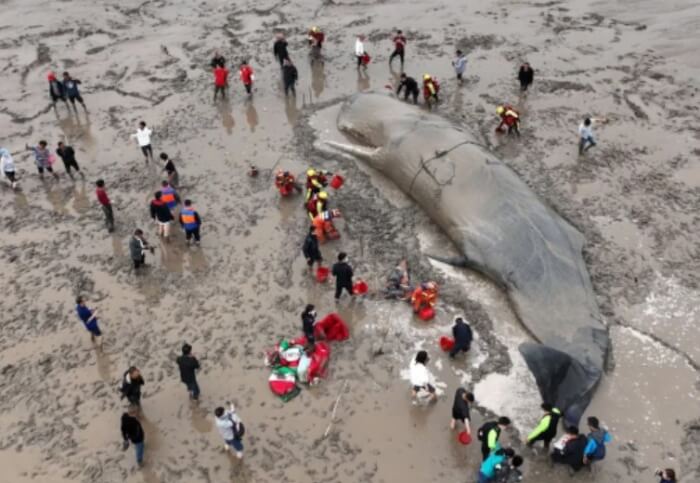ANIMALS
65-Foot Whale Rescued and Returned to the Ocean After 20 Hours of Being Stranded

After 20 hours of continuous rescue operation, a massive 65ft whale was successfully towed back into the ocean from a beach in China.
Initially sighted on Tuesday morning on a beach in Ningbo, located south of Shanghai, the massive mammal was initially mistaken for an orca. The urgency was paramount, as without prompt action, the magnificent creature’s chances of survival were quickly dwindling.
According to Bruce Mate, professor emeritus of fisheries, wildlife, and conservation at Oregon State University’s Hatfield Marine Science Center, the rescue of stranded sperm whales (Physeter macrocephalus) poses significant challenges, and despite intervention, these majestic creatures do not always manage to survive.

Mate told Live Science, “Good on them for making a noble effort in trying to get this animal back to sea, but the odds are quite difficult”.
Despite sharing the need for oxygen with land mammals, whales depend on water to regulate their body temperature and prevent overheating. Moreover, when whales become stranded on beaches, there is a risk of drowning if the rising tide fills the cavity they are in or if the weight of their own bodies causes the ground to give way.
The rescue operation persisted for nearly a full day.
 Image source: Xinhua/REX/Shutterstock
Image source: Xinhua/REX/Shutterstock
Upon discovery along the Xiangshan County shoreline in Ningbo, the whale was reported to be in a critical condition. Firefighters swiftly responded by dispatching a rescue team, who diligently showered the 20-meter-long creature with water and created a makeshift seawater pool in a carefully excavated trench, all in an effort to sustain its life.
Rescuers ingeniously built a trench pool, brimming with replenishing seawater, to ensure the whale’s survival.
 Image source: Xinhua/REX/Shutterstock
Image source: Xinhua/REX/Shutterstock
Ensuring the whale’s survival and rescue proved to be no easy task for the dedicated volunteers, as the sheer magnitude of its estimated 10-ton weight rendered traditional methods such as dragging it to sea or towing it away with a boat impossible.
Ultimately, the resourceful volunteers resorted to excavating a tunnel around the whale’s body, allowing it to be filled with seawater while they brainstormed a viable solution. Diligently, they poured water into the trench, ensuring the whale remained hydrated throughout the arduous process.
When whales become stranded on shore, they face the peril of dehydration or succumbing to their own immense weight.
 Image source: Xinhua/REX/Shutterstock
Image source: Xinhua/REX/Shutterstock
Subsequently, the team securely fastened guide ropes around the whale and skillfully towed it towards shallow waters. Hours later, around 10 pm, as the tide finally reached a sufficient height, the relentless rescuers harnessed the power of five boats to diligently maneuver the whale further into the depths of the water. This relentless effort, spanning 20 hours of nonstop struggle, was crucial in preserving the magnificent creature’s life.
Around 5:30 am on Wednesday, the dedicated rescue team made the decision to sever the hauling cable, liberating the whale to gracefully swim away into the vastness of the deep waters.
The whale’s weight is estimated to be approximately 10 tons.
In due course, the whale was successfully pulled back into the depths of the sea.
 Image source: Xinhua/REX/Shutterstock
Image source: Xinhua/REX/Shutterstock
 Image source: Xinhua/REX/Shutterstock
Image source: Xinhua/REX/Shutterstock
Following the gripping rescue operation, the whale gracefully ventured into the distance, propelled by the combined efforts of the boats and the rising tide, as the sun majestically ascended. Show your heartfelt appreciation for the whale’s existence by sharing your thoughts in the comment section below.
ANIMALS
Amazing Video of Unseen Ocean Creatures in the Ningaloo Canyons

The Schmidt Ocean Institute recently explored the Ningaloo Canyons on the western coast of Australia using a robotic underwater vehicle called the ROV Sebastian. Check out the amazing video of what they discovered in the deep parts of the Indian Ocean.
More info: Youtube




ANIMALS
These Pics Are Art and the Artists Are Insects

Flying insects move so quickly that they are hard to follow, but new technology and some smart ideas have helped Spanish photographer Xavi Bou do just that. After spending 10 years focusing on birds in flight for his Ornithographies project, he turned his attention to insects.
For Entomographies, he uses high-speed video footage taken by Adrian Smith, an insect expert at North Carolina State University, to study and record how insects move. Bou then picks multiple frames and combines them into single images that show the fast movements of one or more insects through space and time.
With Smith’s help, Bou has captured the aerial tricks of wasps, the jumps of leafhoppers, and the fluttering of butterflies in amazing detail. He hopes that by doing this, he can make people more aware of the decline in important insect populations around the world.
1. Zebra longwing
This butterfly, which is common in many areas of the Americas, really fits its name. It can fly very high with just a few flaps of its large wings.
 Image source: nationalgeographic
Image source: nationalgeographic
2. Two-lined spittlebug
This insect, which comes from the eastern United States, is often seen as a pest because it likes to eat grass. Its springy back legs can make it jump into the air like a rocket.
 Image source: nationalgeographic
Image source: nationalgeographic
3. Yellow-collared scape moth
Unlike most moths, this North American species flies during the day. Its shiny blue-black wings sparkle in the sunlight.
 Image source: nationalgeographic
Image source: nationalgeographic
4. Ailanthus webworm moths
These tropical moths have spread farther north in the U.S. Because of their larval host, the invasive tree of heaven, they are now one of the most common backyard moths in the country.
 Image source: nationalgeographic
Image source: nationalgeographic
5. Common stonefly
Mostly found in eastern North America, this insect starts its life as an underwater nymph in forested streams or rivers. Then it leaves the water, sheds its skin, and becomes an adult with wings.
 Image source: nationalgeographic
Image source: nationalgeographic
6. Green lacewings
Eighty-seven species of this insect have been found in the U.S. and Canada. Since they eat a lot of unwanted plant pests like aphids and mites, they are often used to naturally control these pests.
 Image source: nationalgeographic
Image source: nationalgeographic
7. Grapevine beetle
This insect, fittingly named, eats the leaves and fruit of grapevines, both wild and farmed, but it doesn’t do much damage to the plants. As a type of scarab beetle, it often flies in a curved path.
 Image source: nationalgeographic
Image source: nationalgeographic
8. Oak treehopper and green treehopper
Treehoppers are known for their uniquely shaped pronotum, the part behind their head, which often looks like plant parts to hide from predators. They can jump well thanks to special muscles.
 Image source: nationalgeographic
Image source: nationalgeographic
9. Banded orange
This brightly colored butterfly can be found from Mexico to Brazil. Before mating season, male butterflies look for mineral salts, sometimes even drinking salty fluids from the skin, eyes, and nostrils of other animals.
 Image source: nationalgeographic
Image source: nationalgeographic
10. Sapho longwing
Longwings can live for 6 to 7 months, longer than most butterflies. This type, found from Mexico to Ecuador, has shiny blue wings, which is why it’s also called the Sapphire longwing.
 Image source: nationalgeographic
Image source: nationalgeographic
ANIMALS
Eagle and Fox in an Epic Midair Battle Over a Rabbit, Were Captured by a Photographer

Wildlife photography often depends on the perfect combination of good timing and the right place.
That’s exactly what happened when Kevin Ebi, an experienced wildlife photographer, captured an incredible battle between a bald eagle and a red fox, both competing for a rabbit meal.
In a detailed blog post, Ebi shares the fascinating series of events that unfolded while he was photographing foxes in San Juan Island National Historical Park, located in Washington state.
Ebi noticed a lively group of eight fox kits as they began their hunting lessons. Suddenly, they spotted a rabbit, and a thrilling chase ensued. Eventually, one of the foxes emerged as the winner, proudly carrying the rabbit across the field.
 Image source: Kevin Ebi
Image source: Kevin Ebi
Ebi shares what happened at that moment: “As I followed the fox with my camera, a sudden bald eagle cry caught my attention. It was swiftly approaching, clearly aiming for the rabbit. I quickly focused on the fox, anticipating a quick turnover of events.”
To Ebi’s astonishment, instead of a quick surrender, the situation turned into a intense fight in the air.
The eagle used its power to lift the fox and rabbit high up in the sky. Even while airborne, the fox attempted to break free by swinging back and forth.
 Image source: Kevin Ebi
Image source: Kevin Ebi
 Image source: Kevin Ebi
Image source: Kevin Ebi
 Image source: Kevin Ebi
Image source: Kevin Ebi
In the end, the eagle moved the rabbit to its other claw, causing the fox to let go. The intense battle came to an end in less than 10 seconds.
 Image source: Kevin Ebi
Image source: Kevin Ebi
For those worried about the fox’s well-being after the fight, Ebi reassures that it was not injured. The fox swiftly bounced back from the encounter and resumed its playful behavior with the other young foxes, showing no visible wounds from the aerial clash.
 Image source: Kevin Ebi
Image source: Kevin Ebi
 Image source: Kevin Ebi
Image source: Kevin Ebi
 Image source: Kevin Ebi
Image source: Kevin Ebi
 Image source: Kevin Ebi
Image source: Kevin Ebi
-

 GARDEN10 tháng ago
GARDEN10 tháng ago4 Easiest Ways to Get Free Plants
-

 ANIMALS10 tháng ago
ANIMALS10 tháng agoBritish Angler Caught Huge 67-Pound Goldfish in the World
-

 FUNNY10 tháng ago
FUNNY10 tháng ago30 Funny and Perplexing Photos That Make You Laugh All Day
-

 GARDEN9 tháng ago
GARDEN9 tháng ago30 Shimmering Side Yard Landscape Ideas
-

 FUNNY10 tháng ago
FUNNY10 tháng ago30 Weirdest Things That People Came Across On The Subway
-

 DIY & CRAFT10 tháng ago
DIY & CRAFT10 tháng ago19 Easy and Creative DIY Ideas to Enhance Front Yard
-

 ANIMALS10 tháng ago
ANIMALS10 tháng agoKindhearted Driver Rescues Skinny Dog Hiding Near Highway Thanks to His Eagle Eye
-

 FUNNY10 tháng ago
FUNNY10 tháng ago22 Design Fails That Will Make You Laugh Out Loud





